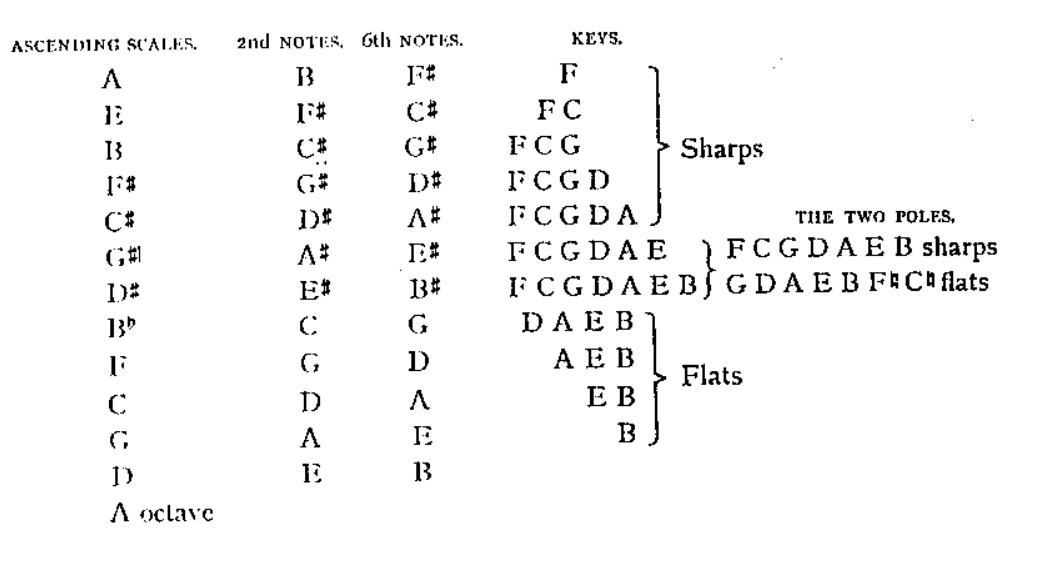Hughes
THE same laws are followed here as in the development of the major scales. In that of A, F, the sixth note, has risen to F#, in order to meet B, which has previously sounded. In descending, the seventh note, B, falls to B?, in order to meet F, which has also previously sounded. The notes, ascending or descending, always follow the harmony of their key-note, except when rising higher or falling lower to meet in fifths. We may here trace the twelve, the ascending scale sounding the fifth harmony higher than its key-note, and, in descending, sounding the fifth lower harmony. The four pairs of each scale are written at the end of the lines. If we strike the twelve scales as they follow in succession, the thirteenth note being the octave of the first, and leader of a higher twelve; having gained them six times, at the seventh they gradually rise (though beyond the power of a keyed instrument) into the higher series of seven octaves, and again, in descending, they fall lower, and are linked into the lower series of seven octaves. Nine notes of any ascending minor scale may be struck without the necessity of modulating beyond the fifth harmony. For example, in the scale of A, its tenth note, C#, rises to meet the sixth note, which has previously sounded. In descending, E?, the eleventh note, meets B?, the seventh note, which has previously sounded. The scale of A may be traced veering round by reference to Diagram IX., beginning with A, and carrying the four lowest notes an octave higher, F rising to F# in ascending, B falling to B? in descending. [Harmonies of Tones and Colours, Diagram XI - The Twelve Minor Keynotes with the Six Note of Each, page 36a]
If we strike the ascending scales as written in musical clef again, beginning with the lowest A in the bass clef, we see that the second and sixth notes of each scale meet in higher harmony; the sharp or flat of the scale which varies from the seven notes of its harmony is written to each note. We descend as written in musical clef upwards; each third and seventh note meet in lower harmony, and thus all exactly agree in their mode of development. Having examined the scales as written in the table below, where the sharp or flat as before is marked to each note, but not to the keys, let us strike the key-notes, trinities, scales, and chords. The three harmonies of each key are written at the end of each line of musical clef. To descend, we follow the musical clef upwards, as before. [Harmonies of Tones and Colours, Diagram XIV - The Modulating Gamut of the Twelve Minor Keys by Fifths2, page 40]

sixth note, which would be Creation perfected, without entering upon the fifth higher key; and it cannot sound the seventh falling into the octave without discord. Therefore the eighth note is not the octave of the first, as it is the fourth note of the fifth higher key. [Harmonies of Tones and Colours, Supplementary Remarks, page 54]
The Major Scales are the type of Creation perfected—man being created, and the Almighty resting—every Major Scale developing the sixth and seventh notes, and the eighth the octave of the first. Therefore, every Major Scale includes the Sabbath, or Rest. [Harmonies of Tones and Colours, Supplementary Remarks, page 54]
The Minor Gamut modulating in the meeting of fifths through seven octaves. We may here trace the twelve, each fifth note becoming the higher key-note. But the sixth and seventh notes of the scale are discords. For example, in the key of A, the sixth note, F?, is a discord with the second note, B?; and the seventh note cannot be sounded as G# falling into the eighth, without being a discord with the third note, C?. No octave can be sounded in the Minor Scale, as it has risen into the fifth higher key of E. [Harmonies of Tones and Colours, The Minor Gamut Modulating in the Meeting of Fifths61, page 65]
See Also
eighth note
fifth note
first note
fourth note
Keynote
mathematical series of notes
Note
second note
seven notes
seventh note
six notes
sixth note
third note
thirteenth note
thirteenth note octave
twelve keynotes
twelve notes
